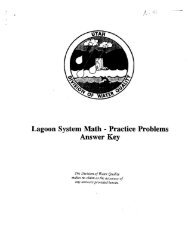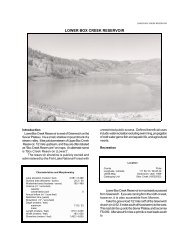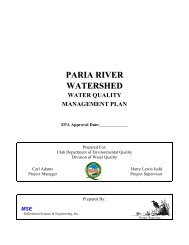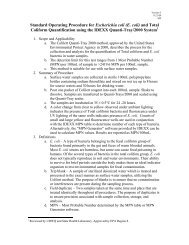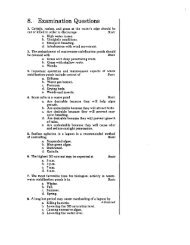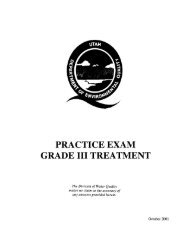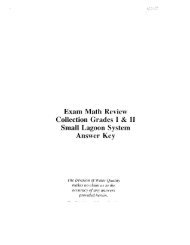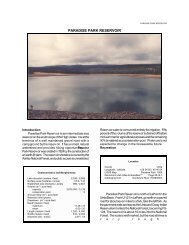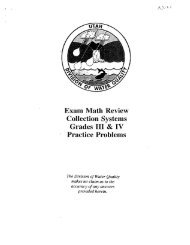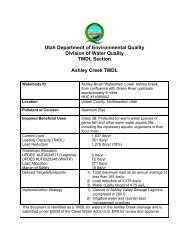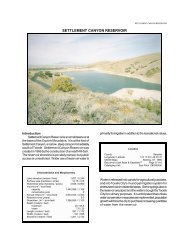Water Spreading in the DesertMario R. Lluria – HydroSystems Inc.In the late 1980s, the portion ofthe Central Arizona Project (CAP)aqueduct that conveys water fromthe Colorado River to Phoenix wascompleted. At the time, the Salt RiverValley lacked sufficient surface storagecapacity for Arizona’s unused portionof CAP water, <strong>and</strong> storage in the distantreservoirs of the Salt <strong>and</strong> Verde rivers wasprohibitively expensive. Consequently,the Salt River Project (SRP) <strong>and</strong> severalmunicipalities agreed to develop a largeunderground water storage facility. A studyfunded by the Arizona Municipal WaterUser Association (AMWUA) identifiedfavorable sites in the Salt <strong>and</strong> Agua Friarivers for in-channel groundwater recharge,a method successfully used for manyyears in the Los Angeles Basin to storewater in the underlying alluvial aquifer.The First Facility: GRUSPIn 1986, the City of Mesa <strong>and</strong> SRPinitiated work on a large water-spreadingrecharge facility in the East Salt RiverValley. Based on the AMWUA study,SRP evaluated a 7-mile-long reachof the lower Salt River immediatelydownstream of Granite Reef Dam, <strong>and</strong>found favorable hydrogeologic conditionswith no environmental constraints.Four potential sites were selected, allnear the SRP water delivery system <strong>and</strong>its large-capacity wells, providing thenecessary supporting infrastructure. In1987, Phoenix-area municipalities joinedwith SRP to select a site, acquire the l<strong>and</strong>,<strong>and</strong> design, permit, construct, <strong>and</strong> operatethe regional Granite Reef Underground<strong>Storage</strong> Project (GRUSP). More than 90percent of the site would be within the SaltRiver Pima-Maricopa Indian Reservation.Negotiations with the tribal governmentconcluded in 1992 with the leasing of a350-acre parcel for a period of twentyyears. Every five years the l<strong>and</strong> is reappraised<strong>and</strong> the rent adjusted accordingto current value. The main determinant isthe value of the l<strong>and</strong>’s s<strong>and</strong> <strong>and</strong> gravel,which is in high dem<strong>and</strong>. Thus, a steady,substantial rent increase has affectedthe unit cost of recharge at GRUSP.The permit process for GRUSPcommenced in 1987 <strong>and</strong> was completedin 1992. Two federal permits wererequired under the Clean Water Act,one each from the U.S. EnvironmentalProtection Agency <strong>and</strong> the Army Corpsof Engineers. State permits were issuedby the Arizona Department of WaterResources (for underground storage) <strong>and</strong>the Arizona Department of EnvironmentalQuality (for aquifer protection).Construction <strong>and</strong> OperationIn 1994, four recharge basins with a totalarea of 174 acres were completed. Twomore added in 1999 increased the areato 225 acres. Originally, CAP water <strong>and</strong>water from the Salt <strong>and</strong> Verde rivers wereused for recharge; in 2007 reclaimedwater was added. The waters are mixedbefore entering the recharge basins.One of the most important factors inGRUSP’s successful operation is the site’sfavorable hydrogeologic characteristics.On the periphery of the large Salt RiverValley tectonic basin, the site’s coarsegrainedunconsolidated s<strong>and</strong>s <strong>and</strong> gravelshave high permeability <strong>and</strong> water storagecapacity, producing recharge rates of 2 to7 feet per day. The storage capacity of thearea of hydrologic impact exceeds onemillion acre-feet. Over 920,000 acre-feetof water have been stored in GRUSP,both short-term <strong>and</strong> long-term, over its13 years of operation (Lluria, 1998).View of the Granite Reef Underground <strong>Storage</strong> facility in 1995, showingcanals transporting CAP water to the facility in the Salt River Valley.28 • May/June 2008 • <strong>Southwest</strong> <strong>Hydrology</strong>
The cost of construction of the GRUSPfacility was $1.2 million, with a totalproject cost at the start in May 1994 of$2.2 million. Ownership of GRUSP isheld by SRP <strong>and</strong> the cities of Ch<strong>and</strong>ler,Gilbert, Mesa, Phoenix, Scottsdale, <strong>and</strong>Tempe. The recharge capacity for eachcity is based on entitlement, with rechargerights based on percent ownership. Otherentities have also used GRUSP; of these,the Arizona Water Banking Authority hasaccumulated the most water storage credits.Challenges <strong>and</strong> SolutionsGRUSP has faced some challenges.All delivery <strong>and</strong> recharge facilities areconstructed of river bed material <strong>and</strong> aresubject to damage during stormwaterreleases from Granite Reef Dam. Damagecaused by such releases are of primaryconcern because of reconstruction costs,but only three flood events, in the wintersof 1995, 2005, <strong>and</strong> 2008, have occurred sofar. Successful mitigation measures haveincluded breaching some of the structuresto route flows <strong>and</strong> minimize erosion.In 1994, a sanitary l<strong>and</strong>fill was completedone mile north of the GRUSP site.Groundwater mounding under thel<strong>and</strong>fill is controlled by regulating inflow,rotating the operating recharge basins,<strong>and</strong> increasing the hydraulic gradientaway from the l<strong>and</strong>fill by pumping.Evapotranspiration losses are minimizedby controlling the vegetation in thedelivery <strong>and</strong> recharge units of the facility.Benefits AccruingThe principal benefit of GRUSP has beenreplenishment of the aquifer beneath theEast Salt River Valley. The equivalentof 40 percent of the total water storagecapacity of SRP’s reservoir system forthe Salt <strong>and</strong> Verde rivers has been addedto the aquifer for future recovery. As thefirst ASR project in the Phoenix area,GRUSP was able to store a large volumeof CAP water which otherwise wouldhave gone to California. The rechargeoperation has also improved the qualityof groundwater near the site by reducingarsenic <strong>and</strong> nitrate concentrations. Finally,GRUSP has improved SRP’s operationalflexibility <strong>and</strong> the water managementpractices of several municipalities.On the West Side: NAUSPTo provide aquifer storage services to thewestern Phoenix metropolitan area, SRPconstructed the New River Agua FriaGRUSP was able tostore a large volumeof CAP water whichotherwise would havegone to California.Underground <strong>Storage</strong> Project (NAUSP)with four partnering municipalities.Agricultural l<strong>and</strong> was purchased on theeastern bank of the Agua Fria River in itsancestral fluvial system, where favorablehydrogeologic characteristics existedfor direct surface groundwater recharge(Paski <strong>and</strong> Lluria, 2005). The site is on theperiphery of a large cone of depression,where considerable l<strong>and</strong> subsidencehas occurred <strong>and</strong> aquifer replenishmentis urgently needed (Lluria, 1995).NAUSP was completed in March 2007 <strong>and</strong>stored 21,000 acre-feet of water last year,achieving recharge rates of 1 to 3 feet perday. The facility consists of six off-channelbasins with a 126-acre infiltration area. Aseventh in-channel basin of 65 acres will beadded in 2008. The facility receives waterfrom CAP <strong>and</strong> the Salt <strong>and</strong> Verde rivers,plus a small volume of reclaimed water. Thewaters are blended before recharging. TheNAUSP facility is permitted for a maximumvolume of 75,000 acre-feet per year, 40percent of the permit capacity of GRUSP.During facility development, a fewdifficulties had to be resolved. Theoriginal site in the Agua Fria Riverchannel was ab<strong>and</strong>oned because ofits proximity to future gravel miningoperations. Topsoil from the agriculturalfields had to be removed for constructionof the off-channel basins to ensureadequate infiltration rates <strong>and</strong> eliminatepotential agriculture contaminants. Thecost of l<strong>and</strong> was high because of itsproximity to the recently completedCity of Glendale sports center.NAUSP will provide a much-neededunderground storage facility for the area,particularly for the temporary storageof reclaimed water. It will capture flowsin the tail end of the SRP system thatmight otherwise go unused. The rechargeactivity will improve groundwaterquality near the site by diluting the highnitrate concentrations caused by decadesof agriculture. Having two rechargefacilities, one located near the head ofthe water delivery system, the othernear its terminus, considerably increasesthe operational flexibility of SRP’swater resources management system.Contact Mario Lluria at mario@hydrosystems-inc.com.ReferencesLluria, M.R., 1995. Site selection for aquifer storageprojects in the Lower Agua Fria Basin, in Proc.7th Biennial Symp. on Artificial Groundwater<strong>Recharge</strong>, Santiago, Chile.Lluria, M.R., 1998. Successful operation of a largeaquifer storage facility for a desert community,in Artificial <strong>Recharge</strong> of Groundwater, ed. J.H.Peters, Rotterdam, A.A. Balkema.Paski, M.P., <strong>and</strong> M.R. Lluria, 2005. Hydrogeologic<strong>and</strong> geologic considerations for site selection ofa large water spreading facility in the West SaltRiver Valley., in Proc. 12th Biennial Symp. onGroundwater <strong>Recharge</strong>, Tucson, AZ.Total Water Management19,000 professionals serving your needs in: Solutions Without Boundariesch2mhill.com Tel: 505.884.1682 x205 Tel: 480.966.8577 x6239WB052007020MKT© 2007 CH2M HILLMay/June 2008 • <strong>Southwest</strong> <strong>Hydrology</strong> • 29



